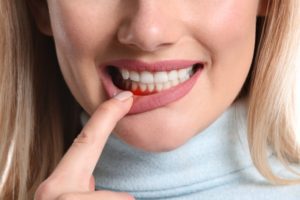If you’ve visited your dentist often enough, you may have heard them use the words “gingivitis” and “periodontitis.” In fact, you might even realize the terms have to do with gum problems. However, there’s a good chance you don’t know their precise meanings. The short answer is that they refer to the two distinct stages of gum disease. If you want the long answer, though, your local dental practice can help. Learn how gingivitis and periodontitis differ as forms of gum disease with a Scripps Ranch dentist.
So, What’s Gingivitis?
Put simply, gingivitis is the first stage of gum disease. It manifests as chronic gum inflammation, harming the pink tissue around your teeth.
Gingivitis occurs when plaque builds up in your mouth. As the sticky film gets stuck between your pearly whites, it irritates your gums and causes them to turn red and swollen. Since this irritation is minor, though, it doesn’t cause issues like gum recession.
Thankfully, dentists can reverse gingivitis with teeth cleaning. If you follow up on that service with good oral hygiene, you can keep the condition at bay.
What’s Periodontitis?
Left untreated, gingivitis advances to the second stage of gum disease — periodontitis. When the latter develops, previous symptoms worsen and your gums begin receding. The tissue also forms pockets that can become infected.
At this stage of gum disease, teeth are no longer anchored in place. Your condition will weaken and break the bonds that keep them secure. As such, your pearly whites will loosen and likely fall out over time.
Unlike gingivitis, periodontitis is irreversible. At best, dental treatment will only help you manage the problem.
How To Tell Whether You Have One or the Other
Gingivitis and periodontitis have similar symptoms, but there are ways to tell whether you have one or the other. In particular, consider the following:
- Your Age: Periodontitis is rare in kids and teens. In contrast, they can still develop gingivitis.
- Your Pain (if any): If you feel pain when you chew, your gingivitis has likely progressed to periodontitis.
- Your Tooth Condition: Your gums might be irritated when you have gingivitis, but your teeth will remain in place. However, having loose teeth means you probably have periodontitis.
- Your Breath: Periodontitis triggers persistent bad breath, as it causes an excess buildup of smelly bacteria in your mouth.
As you can see, it’s essential to know the stages of gum disease in Scripps Ranch. Having that knowledge will help you get effective dental treatment!
About the Author
Dr. Greg Friedman is a dentist in San Diego, CA, having earned his DDS from Washington University’s School of Dental Medicine. He’s also received training from the world-renowned Barnes Medical Center in St. Louis. As such, his specialties are preventive, cosmetic, and restorative dental treatments — and that also includes periodontal therapy! Dr. Friedman currently practices at Mod Squad Dental and is reachable on his website or by phone at (858)-547-0070.




